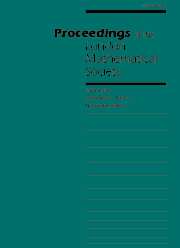Crossref Citations
This article has been cited by the following publications. This list is generated based on data provided by
Crossref.
2000.
Random Graphs.
p.
307.
P. Godbole, Anant
and
C. Graziano, Heidi
2001.
Contributions to the problem of Zarankiewicz.
Journal of Statistical Planning and Inference,
Vol. 95,
Issue. 1-2,
p.
197.
Kohayakawa, Y.
and
Rödl, V.
2003.
Regular pairs in sparse random graphs I.
Random Structures & Algorithms,
Vol. 22,
Issue. 4,
p.
359.
Friedgut, Ehud
Rödl, Vojtěch
and
Schacht, Mathias
2010.
Ramsey properties of random discrete structures.
Random Structures & Algorithms,
Vol. 37,
Issue. 4,
p.
407.
Janson, Svante
and
Ruciński, Andrzej
2011.
Upper tails for counting objects in randomly induced subhypergraphs and rooted random graphs.
Arkiv för Matematik,
Vol. 49,
Issue. 1,
p.
79.
Alon, Noga
Balogh, József
Morris, Robert
and
Samotij, Wojciech
2014.
Counting sum-free sets in abelian groups.
Israel Journal of Mathematics,
Vol. 199,
Issue. 1,
p.
309.
Balogh, József
Morris, Robert
and
Samotij, Wojciech
2014.
Random sum-free subsets of abelian groups.
Israel Journal of Mathematics,
Vol. 199,
Issue. 2,
p.
651.
BUSHAW, NEAL
COLLARES NETO, MAURÍCIO
MORRIS, ROBERT
and
SMITH, PAUL
2015.
The Sharp Threshold for Maximum-Size Sum-Free Subsets in Even-Order Abelian Groups.
Combinatorics, Probability and Computing,
Vol. 24,
Issue. 4,
p.
609.
BALOGH, JÓZSEF
BOLLOBÁS, BÉLA
and
NARAYANAN, BHARGAV P.
2015.
TRANSFERENCE FOR THE ERDŐS–KO–RADO THEOREM.
Forum of Mathematics, Sigma,
Vol. 3,
Issue. ,
Conlon, David
and
Gowers, W. Timothy
2016.
Combinatorial theorems in sparse random sets.
Annals of Mathematics,
Vol. 184,
Issue. 2,
p.
367.
Schacht, Mathias
2016.
Extremal results for random discrete structures.
Annals of Mathematics,
Vol. 184,
Issue. 2,
p.
333.
Bollobás, Béla
Narayanan, Bhargav P.
and
Raigorodskii, Andrei M.
2016.
On the stability of the Erdős–Ko–Rado theorem.
Journal of Combinatorial Theory, Series A,
Vol. 137,
Issue. ,
p.
64.
Robertson, Aaron
2016.
A probabilistic threshold for monochromatic arithmetic progressions.
Journal of Combinatorial Theory, Series A,
Vol. 137,
Issue. ,
p.
79.
Saxton, David
and
Thomason, Andrew
2016.
Online containers for hypergraphs, with applications to linear equations.
Journal of Combinatorial Theory, Series B,
Vol. 121,
Issue. ,
p.
248.
Rué, Juanjo
Serra, Oriol
and
Vena, Lluis
2017.
Counting configuration-free sets in groups.
European Journal of Combinatorics,
Vol. 66,
Issue. ,
p.
281.
Kusch, C.
Rué, J.
Spiegel, C.
and
Szabó, T.
2017.
Random Strategies are Nearly Optimal for Generalized van der Waerden Games.
Electronic Notes in Discrete Mathematics,
Vol. 61,
Issue. ,
p.
789.
Rué, Juanjo
Spiegel, Christoph
and
Zumalacárregui, Ana
2018.
Threshold functions and Poisson convergence for systems of equations in random sets.
Mathematische Zeitschrift,
Vol. 288,
Issue. 1-2,
p.
333.
Kusch, Christopher
Rué, Juanjo
Spiegel, Christoph
and
Szabó, Tibor
2019.
On the optimality of the uniform random strategy.
Random Structures & Algorithms,
Vol. 55,
Issue. 2,
p.
371.
Hancock, Robert
Staden, Katherine
and
Treglown, Andrew
2019.
Independent Sets in Hypergraphs and Ramsey Properties of Graphs and the Integers.
SIAM Journal on Discrete Mathematics,
Vol. 33,
Issue. 1,
p.
153.
Hancock, Robert
2019.
The Maker--Breaker Rado Game on a Random Set of Integers.
SIAM Journal on Discrete Mathematics,
Vol. 33,
Issue. 1,
p.
68.


